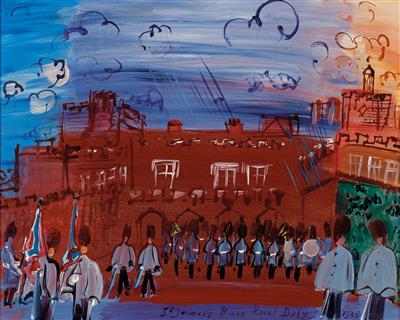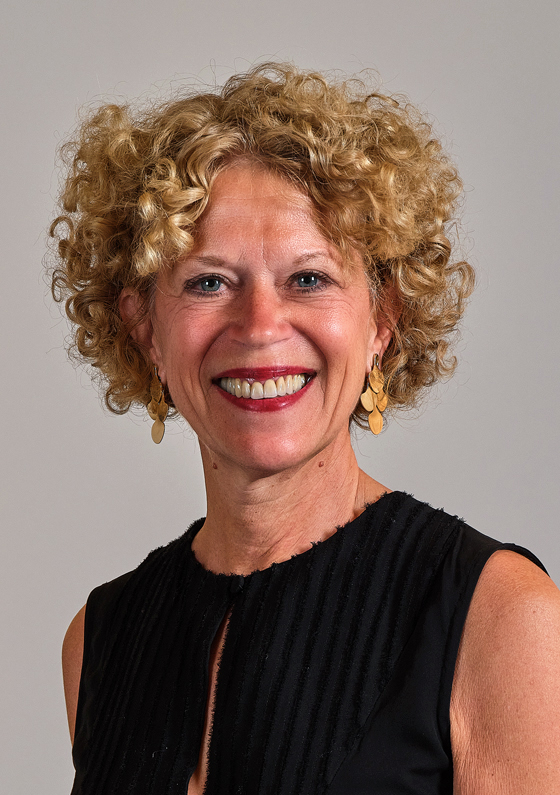Raoul Dufy *

(Le Havre 1877–1953 Forcalquier)
‘St. James’s Palace’, titled, signed and dated Raoul Dufy 1935, oil on canvas, 33.5 x 41.5 cm, framed, (PS)
Photo certificate:
Maurice Laffaille, Neuilly, 7 June 1977
Literature:
Maurice Laffaille, Raoul Dufy. Catalogue raisonné de l’oeuvre peint, vol. IV, Geneva 1977, p. 121, no. 1550 bis
Provenance:
Sotheby’s New York, 6.11.2003, lot 0234,
acquired there from the previous owner.
Raoul Dufy gathered a wide range of impressions on his many journeys dating from the early 1920s onwards, and these inspired him to depict not only various landscape forms in the changing light, but also to concentrate his efforts on illustrating popular city views.
Music is the main focus of the present work, St. James’s Palace, and was directly, and indirectly, of great importance to Raoul Dufy’s oeuvre as a whole. As with the military orchestra here at St. James’s Palace in London, music takes centre stage in many of his paintings and drawings. The fine colour combinations are reminiscent of tone sequences, subtle indications of Dufy’s love of music, while his later still lifes are direct references to works by Debussy and Mozart. Sound is translated into colour and form, repeated on the canvas like notes in a melody. “The melodic motif and instrumental tones stand out prominently above the overall sound of the orchestra, allowing us to imagine that a group of instruments has been especially illuminated, and lent a form which has nothing to do with the instrument or its player, but is only intended as an abstract sign, representing a particular point in the music. Thus a particular note played on the flute can be identified by lighting up two or three musicians in a coppery green and white light as if struck by lightning. […] the violins are shown as a sinuous horizontal line moving in a single direction…the trombones or trumpets take the form of a star; the kettledrums a clover leaf, and the violas yellow clouds”.(1) In St. James’s Palace, the sound level of the military band is also visualised through the palace’s architectural elements, hinted at by means of the diagonal, upward-moving parallel brushstrokes and the stylised clouds, executed in a Futurist style. An extreme contrast is provided by the stark and apparently motionless soldiers, bearing their flags and playing their music. “I want to express the things the way my eyes see them and how my heart feels them. Others may have interpreted them with greater skill than I; but it was because of this inability that I was forced to consider these aspects in greater depth, to understand them and to learn to adapt my intentions.”(2)
(1) Jacques Laissaigne, Dufy, Geneva 1954, p. 81 f
(2) ibid., p. 84
Expert: Dr. Petra Maria Schäpers
 Dr. Petra Maria Schäpers
Dr. Petra Maria Schäpers
petra.schaepers@dorotheum.de
25.11.2014 - 18:00
- Dosažená cena: **
-
EUR 99.693,-
- Odhadní cena:
-
EUR 75.000,- do EUR 90.000,-
Raoul Dufy *
(Le Havre 1877–1953 Forcalquier)
‘St. James’s Palace’, titled, signed and dated Raoul Dufy 1935, oil on canvas, 33.5 x 41.5 cm, framed, (PS)
Photo certificate:
Maurice Laffaille, Neuilly, 7 June 1977
Literature:
Maurice Laffaille, Raoul Dufy. Catalogue raisonné de l’oeuvre peint, vol. IV, Geneva 1977, p. 121, no. 1550 bis
Provenance:
Sotheby’s New York, 6.11.2003, lot 0234,
acquired there from the previous owner.
Raoul Dufy gathered a wide range of impressions on his many journeys dating from the early 1920s onwards, and these inspired him to depict not only various landscape forms in the changing light, but also to concentrate his efforts on illustrating popular city views.
Music is the main focus of the present work, St. James’s Palace, and was directly, and indirectly, of great importance to Raoul Dufy’s oeuvre as a whole. As with the military orchestra here at St. James’s Palace in London, music takes centre stage in many of his paintings and drawings. The fine colour combinations are reminiscent of tone sequences, subtle indications of Dufy’s love of music, while his later still lifes are direct references to works by Debussy and Mozart. Sound is translated into colour and form, repeated on the canvas like notes in a melody. “The melodic motif and instrumental tones stand out prominently above the overall sound of the orchestra, allowing us to imagine that a group of instruments has been especially illuminated, and lent a form which has nothing to do with the instrument or its player, but is only intended as an abstract sign, representing a particular point in the music. Thus a particular note played on the flute can be identified by lighting up two or three musicians in a coppery green and white light as if struck by lightning. […] the violins are shown as a sinuous horizontal line moving in a single direction…the trombones or trumpets take the form of a star; the kettledrums a clover leaf, and the violas yellow clouds”.(1) In St. James’s Palace, the sound level of the military band is also visualised through the palace’s architectural elements, hinted at by means of the diagonal, upward-moving parallel brushstrokes and the stylised clouds, executed in a Futurist style. An extreme contrast is provided by the stark and apparently motionless soldiers, bearing their flags and playing their music. “I want to express the things the way my eyes see them and how my heart feels them. Others may have interpreted them with greater skill than I; but it was because of this inability that I was forced to consider these aspects in greater depth, to understand them and to learn to adapt my intentions.”(2)
(1) Jacques Laissaigne, Dufy, Geneva 1954, p. 81 f
(2) ibid., p. 84
Expert: Dr. Petra Maria Schäpers
 Dr. Petra Maria Schäpers
Dr. Petra Maria Schäpers
petra.schaepers@dorotheum.de
|
Horká linka kupujících
Po-Pá: 10.00 - 17.00
kundendienst@dorotheum.at +43 1 515 60 200 |
| Aukce: | Moderní |
| Typ aukce: | Salónní aukce |
| Datum: | 25.11.2014 - 18:00 |
| Místo konání aukce: | Wien | Palais Dorotheum |
| Prohlídka: | 15.11. - 25.11.2014 |
** Kupní cena vč. poplatku kupujícího a DPH(Země dodání Rakousko)
Není již možné podávat příkazy ke koupi přes internet. Aukce se právě připravuje resp. byla již uskutečněna.
Všechny objekty umělce
